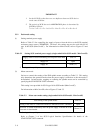
C141-E035-02EN 5 - 13
CAUTION
1. Be careful of the insertion directions of the SCSI connectors. With the
system in which terminating resistor power is supplied via the SCSI
cable, if the power is turned on, the overcurrent protection fuse of the
terminating resistor power supplier may be blown or the cable may be
burnt if overcurrent protection is not provided.
When the recommended parts listed in Table 4.1 are used, inserting
the cables in the wrong direction can be prevented.
2. To connect SCSI devices, be careful of the connection position of the
cable. Check that the SCSI device with the terminating resistor is the
last device connected to the cable.
5.6 Confirming Operations after Installation and Preparation for use
5.6.1 Confirming initial operations
This section describes the operation check procedures after power is turned on. Since the
initial operation of the IDD depends on the setting of the motor start mode, check the initial
operation by either of the following procedures.
(1) Initial operation in the case of setting so that motor starts at powering-on
a) When power is turned on, the LED blinks an instant and the IDD executes initial self-
diagnosis.
b) If an error is detected in the initial self-diagnosis, the LED on the front panel blinks
periodically.
Remark:
The spindle motor may or may not start rotating in this stage.
c) When the IDD status is idle, the LED on the front panel remains off (when the initiator
accesses the IDD via the SCSI bus, the LED lights).
(2) Initial operation in the case of setting so that motor starts with START/STOP command
a) When power is turned on, the LED blinks an instant and the IDD executes initial self-
diagnosis.
b) If an error is detected in the initial self-diagnosis, the LED on the front panel blinks.


















